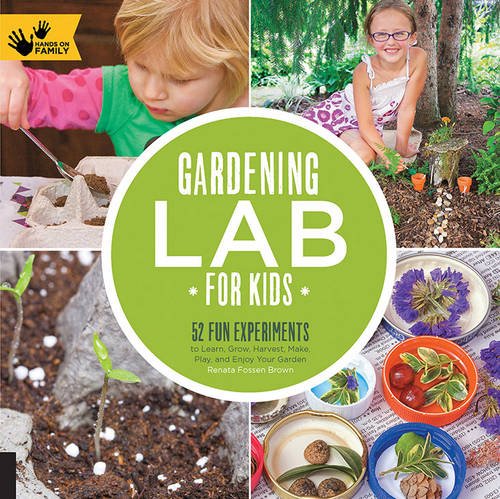This post contains affiliate links. As an Amazon Associate I earn from qualifying purchases
A refreshing source of ideas to help your children learn to grow their own patch of earth, Gardening Lab for Kids encourages children to get outside and enjoy nature. This fun and creative book features 52 plant-related activities set into weekly lessons, beginning with learning to read maps to find your heat zone, moving through seeds, soil, composting, and then creating garden art and appreciating your natural surroundings. Author Renata Fossen Brown guides your family through fun opportunities learning about botany, ecology, the seasons, food, patience, insects, eating, and cooking. The labs can be used as singular projects or to build up to a year of hands-on outdoor experiences. The lessons in this book are open-ended to be explored over and over – with different results each time! Garden Lab for Kids is the perfect book for creative families, friends, and community groups and works as lesson plans for both experienced and new gardeners. Children of all ages and experience levels can be guided by adults and will enjoy these engaging exercises. So, slip on your muddy clothes, and get out and grow!

View larger Lab
Toads (and their close relatives, frogs) are very important for the ecosystem. Both animals’ main diet consists of insects, many of which are pests to food crops,such as aphids or slugs. Wouldn’t it be great to attract them to your yard to keep an eye on your garden?
Materials 10” (25 cm) clay potPaintsPaint brushesClear polyurethaneSealerTrowel  Fig. 1: Decorate the pot, let dry, add sealer, and let dry.
Fig. 1: Decorate the pot, let dry, add sealer, and let dry.
View larger
1. Paint some fun designs on the clay pot and let it dry. Apply the sealer and let dry overnight. (Fig. 1)2. Find a shady, out-of-the-way location in your garden for your toad abode. Using the trowel, dig a slight depression the soil so that when you lay the pot on its side, it won’t roll around. (Fig. 2)3. Lay the pot on its side in the depression you dug. Fill the area around the pot with soil so that the pot will stay in place.
 Fig. 2: Dig a small area for the pot.
Fig. 2: Dig a small area for the pot.
DIG DEEPER! If you aren’t seeing frogs or toads in your neighborhood when there should be some around, there could be something wrong. Lawn chemicals, pollution, or acid rain could be some of the reasons. Both frogs and toads are amphibians, and are key indicators of a healthy environment. Why? Because they breathe and absorb water through their skin! If the environment is polluted, they ingest those pollutants, which can kill them or prevent them from reproducing. Healthy toads, Healthy environment.
This post contains affiliate links. As an Amazon Associate I earn from qualifying purchases
